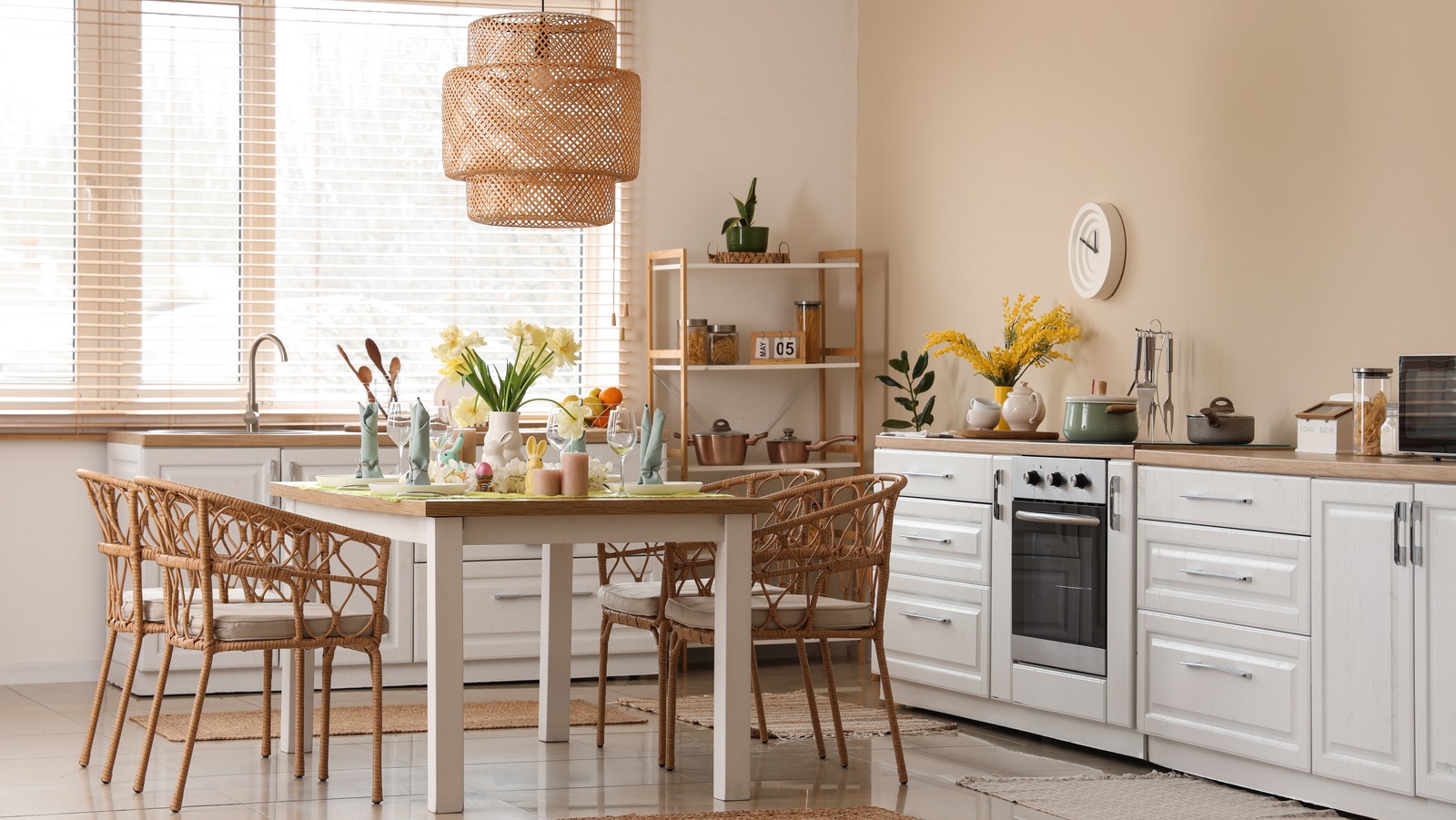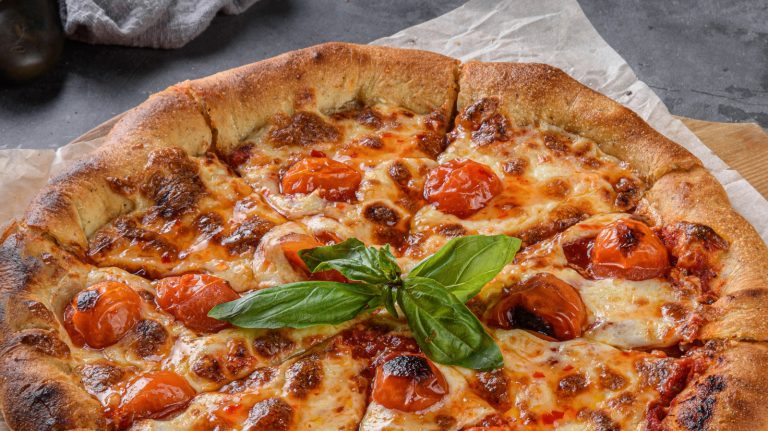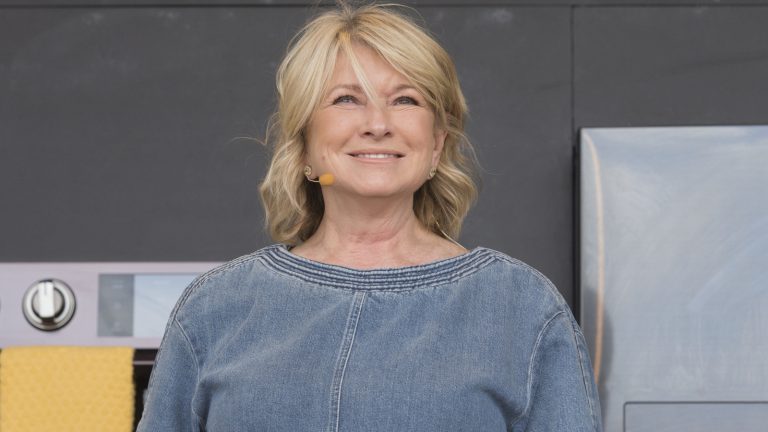We may receive a commission on purchases made from links.
There are two possible approaches to setting up a kitchen: the shove-everything-in-a-cabinet-and-pray-for-the-best method, and the thoughtfully-arranging-items-where-they-make-the-most-sense-and-will-actually-prove-useful method. This writer, having moved almost two dozen times, is very familiar with the first method and passingly familiar with the second. But guess what? The second one works a lot better.
“Your kitchen dictates the way your home will feel functionally,” says Karen Watts, founder and CEO of DomiSource. If it’s disorganized from the start, she says, you’ll lose time, buy duplicate tools, and feel frustrated at mealtimes. “A functional and organized space will allow your whole home to feel ‘moved in,’ not only in a physical sense but in an emotional sense as well.”
If you’re remodeling, then you have a chance to start fresh and think through your kitchen’s layout, utility, and design from the outset. However, even if you’re just moving into a rental apartment, there are plenty of easy kitchen upgrades that require no renovations at all. “A new home is one of the best opportunities to design a kitchen around your specific taste, even from day one,” Seymen Usta, interior design specialist at Seus Lighting, says. “Rather than adjusting to another person’s arrangement, you are able to contemplate how you cook, clean, and behave within your space.” To that end, here are the 19 biggest mistakes to avoid in your first kitchen — and what to do instead.
Designing in a vacuum
“When you first move in, your kitchen is a blank canvas — or a chaos trap, depending on your choices,” says Rocco Carulli, owner and executive chef at R House. Carulli advises designing around function, then adding form. “Putting the knives next to the cutting board isn’t just common sense — it’s kitchen feng shui.”
Designing in a vacuum is where people often get lost. They fall prey to questionable vintage decor trends or down a Pinterest rabbit hole, and end up with a collage of different ideas. Or, they cherry-pick items that don’t make sense together or are more expensive than they have to be, blowing the ability to save money on your kitchen remodel.
One of the worst mistakes to avoid in your first kitchen, says Rachel Blindauer, principal interior designer at Rachel Blindauer, is failing to ask, “Does this support how I live?” Small oversights in planning, such as overloading on upper cabinets, underestimating lighting, ignoring flow, and skipping seating, can compound daily, leading to your irritation and disrupting workflow.
Winging it
“Moving into a new kitchen — whether after a remodel or into a new home — can be overwhelming,” says Heidi Ganser Lang, founder of Juniper Organizing. “In the rush to settle in, we often unpack without much thought, only to realize later that the setup doesn’t really support how we live.” Have a plan, and many of the mistakes to avoid in your first kitchen won’t even come up.
“Kitchen organizing is just like everything else in life: If you wing it, it might work, but if you plan it out, it will probably work,” says Lucy Milligan Wahl, founder of LMW Edits LLC. She concedes that flying by the seat of your pants might be okay in a large kitchen or if you don’t cook a lot, but in a small one, it won’t.
Neglecting transition zones
It’s also helpful to set up your space by zones, as many people make the same kitchen organization mistake of grouping their utensils and tools by size. Rolling pins here, cookie sheets there, coffee cups over yonder. The problem is that when you place objects in a different part of the kitchen from where you’ll use them, you end up with a lot of unnecessary fetching. While this might be a great way to get your steps in, it’s not an efficient approach to throwing a dinner party or cleaning the kitchen.
“The most common error I see is neglecting transition zones — the space between your sink, fridge, and stove,” Karen Watts says. This is also known as the work triangle, and it’s really important to keep it in mind. Seymen Usta agrees that “If there’s too much blank space between those three points, or if something gets in your way, you’ll take unnecessary steps and waste precious time.”
Blocking your light
Another of the most common mistakes to avoid in your first kitchen is blocking the light. “Kitchens thrive in daylight,” Rachel Blindauer says. “Oversized upper cabinets or heavy window treatments can make the space feel smaller and dimmer. Opt for open shelving near windows or lighter treatments that allow light to filter in and bounce around.” You should also avoid putting large plants near windows. Tempting as it is to give them all that light, they steal it from you, and you need it.
Natural light not only enhances mood, Seymen Usta says, it opens up your room visually. Plus, it’s often necessary when you’re making meals where color matters. Whether you’re building a beautiful charcuterie board or garnishing a classic eggs Benedict, light matters. because it shows the true colors of the food with which you’re working. “Let the sunshine in,” Rocco Carulli advises. “Your eyes (and Instagram feed) will thank you.”
Not using wall space well
Especially in small kitchens, wall space is gold. “Those walls aren’t just there to hold your regrets,” Rocco Carulli says, pointing out that the vertical landscape is frequently underlooked. Instead of placing everything in existing cabinets and drawers or on countertops, “Install shelves, magnetic knife strips, or pegboards and turn dead space into prime real estate.”
“Maximizing wall space can do so much to enhance your workflow, particularly in a smaller kitchen,” says Seymen Usta, which is why neglecting it is among the most important mistakes to avoid in your first kitchen. “It’s one of the easiest ways to add more storage space without tearing down walls or bringing in big pieces of furniture.”
Dismissing extra shelving
Related to the use of wall space, overlooking the power of extra shelving is another of the mistakes you’ll want to avoid in your first kitchen (or any kitchen). “If you are moving or renovating, your goal should be access, not just storage,” Karen Watts says. Installing more shelving gives you that. “It keeps everything visual and the counters clear.”
Who should install more shelving, then? “You should add extra shelving if 1) you need more storage and 2) after placing everything on shelves, there is lots of white space between the stuff and the next shelf up,” Lucy Milligan Wahl says. Indeed, she’s often irked at cabinet makers who make the room between shelves too spacious, because it’s a waste. Don’t do it.
Not adding extra lighting
A window and an overhead light do not necessarily make good lighting. Another mistake to avoid in your first kitchen is to leave the lighting as is. “Whenever I renovate a space, I always add under-cabinet and overhead task lighting,” Karen Watts says. “In doing so, you are aiding productivity, safety, and the overall mood.” Your kitchen shouldn’t just be usable during the bright daylight hours. “A well-lit kitchen is usable from a 6 a.m. coffee to a midnight snack. It’s a low-cost investment with high ROI.”
Rachel Blindauer recommends a layered approach, with recessed lighting for general use, task lighting for prep, and pendant lighting for beauty. Plus, Seymen Usta adds, lighting control is important: “Dimmers, motion sensors, and smart lighting systems can significantly elevate your experience.”
Cluttering your countertops
One of the best ways to avoid clutter in your cabinets and everywhere else is to set up your kitchen with intention. Create storage in the cabinets and carry that organization down to the level of the counter so that it never accumulates there, which is one of the biggest mistakes to avoid in your first kitchen.
“Your countertops should be treated as a workspace, not storage,” Heidi Ganser Lang says. “It’s easy to let a couple of appliances live on the counter ‘just for now, but clutter tends to multiply. Store small appliances in a cabinet, pantry, or appliance garage.” You can also use a knife strip to get blocks off the counter and a spice drawer or rack rather than a spinning rack. Simple updates can really maximize freedom of movement.
Not using cabinet zones
Rezoning your cabinets is a truly excellent strategy to avoid confusion and clutter in your kitchen, no matter how small. “Think of your kitchen storage in three zones,” Heidi Ganser Lang says. These include prime real estate, marginal real estate, and off-the-beaten-path storage, with each dedicated to specific uses.
In the first, you should place “Easy-to-reach spaces for everyday items like silverware, dishes, glasses, and your go-to cookware,” she says. The second should consist of “Higher or lower shelves for things you use weekly: specialty baking dishes, serving bowls, or fine stemware.” Anything you only use once in a while — think holiday items, backup appliances, and picnic baskets — belongs at the top of the pantry or in that annoying cabinet above the fridge.
Leaving cabinets and pantries in the dark
Most cabinets, and even a lot of pantries, come unlit, and that’s a problem. “No one wants to spelunk for canned tomatoes,” Rocco Carulli says. “A well-lit pantry is the difference between a quick meal and a scavenger hunt.”
If you’re remodeling, you can address this at the outset. If you’ve just moved into a house or apartment that you didn’t design, that’s okay too. “LED strips or puck lights in pantries and deep cabinets turn forgotten corners into usable space,” Rachel Blindauer says. “They also create a boutique-like experience, which elevates everyday moments.” Consider options such as the Star-Spangled Push Tap Light or these Under Cabinet Lights, which are simple to install without a lot of tools or help.
Choosing overly trendy colors
Another of the mistakes to avoid in your first kitchen, Rachel Blindauer says, “Another trap is the urge to make it all match or to lean too heavily into trends. Kitchens aren’t outfits. You don’t want to be repainting every three years because blush pink felt like a good idea after two cocktails and a scroll through Instagram.” Not that this would ever happen to any of us. *Slinks away sheepishly.*
Rocco Carulli agrees that you should stick to timeless colors you really love, not the latest TikTok color trend: “That avocado green may scream ‘cutting edge’ today, but in six months it’ll literally just scream.” Then, as Blindauer says, you’ll face the choice of repainting or just living with it.
Not matching your hardware
“Too many hardware finishes can easily make a kitchen feel disjointed and cluttered,” Seymen Usta says. “While mixing metals can be chic when it’s a deliberate decision, five different finishes create visual chaos.” He advises you to choose one dominant finish, then use a faint accent finish if you really must. “This helps the space feel cohesive and well-designed.”
The good news is, changing out kitchen knobs is an excellent way to refresh your kitchen, and it doesn’t cost much, so anywhere you can match your hardware, you should. Plus, most landlords don’t mind if you change out knobs and handles. They may ask you to change it back, or they may not. Just make sure to take a thoughtful approach. “Mixed metals is a skill,” Karen Watts says. “If you are not confident, stick to one finish with handles, faucets, and fixtures. I learned this the hard way on a remodel,” she adds. “What looked ‘eclectic’ on Instagram was messy in real life.”
Forgetting about prep zones
“Prep zones are critical in a kitchen,” Lucy Milligan Wahl says. “Many people style their kitchen counters with large appliances, decorative platters, and utensil crocks only to find themselves constantly shoving those things out of the way in order to clear a spot for a cutting board or bowl.” Clearing off your counters from the get-go is one of the most functional decisions you can make when setting up a new kitchen.
Beyond that, it’s a good idea to designate places in which you’ll work. “A kitchen without dedicated prep zones is like a stage without wings,” Rachel Blindauer says. “Whether it’s a stretch of countertop near the sink or a butcher block island, make sure there’s breathing room. Your future self will thank you mid-recipe, hands covered in flour.”
Perhaps you keep one stretch of counter clear for baking: rolling out dough, setting warm cookie sheets, or letting freshly dipped truffles set up on a rack. On your island or prep table, if you have one, you can do all your chopping and mixing. And in a corner of the kitchen, you might want to set finished dishes that are ready to go out to the dining room or patio. Whatever you do, Karen Watts says, “Always find room to chop, mix up, or lay out your ingredients.”
Neglecting pot racks
Another of the most egregious mistakes to avoid in your first kitchen is to dismiss pot racks. “Pot racks can be a kitchen’s best friend, especially in small kitchens,” Karen Watts says. “They’re great to keep heavy items out and make room in the cabinets for our other lighter items.” Plus, it’s always obvious where a pot or pan goes when you’re finished with it, freeing you of the cumbersome task of restacking them by size in cabinets and drawers … which gets old fast.
You don’t always have to hang them, either. You can put a Toplife Pots and Pans Organizer Rack for Cabinet and Countertop in an out-of-the-way space or hang a Oropy 23 Inch Wall Mounted Pot Rack Storage Shelf on the wall instead of from the ceiling. “It makes you look like you know what you’re doing — even if your go-to meal is instant ramen,” Rocco Carulli says. And isn’t that everyone’s goal?
Making no room for seating
“A kitchen without a place to sit is like a bar without stools,” Rocco Carulli says. “Whether it’s for morning coffee or unsolicited advice from your mother-in-law, seating matters.” Once you’re done snickering, give this some thought: Where can a guest sit with a glass of wine? Where can a kiddo do a bit of homework while dinner’s going? Failing to think about this is one of the most serious mistakes to avoid in your first kitchen, because it truly influences how you live.
If you have a tiny kitchen, see if you can put a chair or stool under a window. You could also set a small prep table in the middle of the room or keep a floating stepstool for little ones. In a larger one, consider a window seat or breakfast nook so there’s always somewhere to hang.
Falling for deep cabinets
This is one of the biggest mistakes to avoid in your first kitchen, especially if you’re remodeling. Deep cabinets just aren’t that useful. “Deep cabinets and pantries might look like a great storage solution, but they often turn into black holes,” Heidi Ganser Lang says. “If you can’t see it, you won’t use it, and you’ll end up with duplicates or forgotten items.”
The goal is to be able to see everything you own by opening a door. “It’s okay to stack items like matching drinking glasses two or three rows deep, but don’t mix types,” Lang advises. For instance, you don’t want to put a glass behind a coffee mug or wine glass, because you’ll forget they’re back there. You can solve this issue with organizing tools: water bottle racks, lazy susans, or risers.
Storing items randomly
A common kitchen setup error is to just shove everything where they think it will fit rather than where it makes the most sense for cooking, Lucy Milligan Wahl says. “It’s super important to store items you use together, the items you use most frequently in the most accessible spaces, and items associated with appliances near those appliances.” That way, she says, you can get everything you need for a particular project out at once.
Teaspoons and measuring cups should be in the same place. Knives and cutting boards should live next door. And utensils should always go in a big, conveniently placed drawer or crock. Consider an affordable option such as the DOWAN Extra Large Utensil Holder, or get one at the thrift store for pennies on the dollar.
Leaving the floor bare
“Most people forget that standing in a kitchen for hours makes being barefoot uncomfortable,” Karen Watts says. “I always utilize washable mats at the sink and stove. It mitigates fatigue and the slipping.” This is in line with her whole ethic vis-à-vis setting up kitchens: “Start with how you live, not how it looks. Organize for your real routines, real-time constraints, and real lifestyle.”
In other words, if you cook a lot — and therefore clean up a lot afterward — make sure you’re comfy doing it. Ignoring this is one of the biggest mistakes to avoid in your first kitchen, because you’re ignoring your own needs. It doesn’t have to cost a lot, either: Rugsure Washable Area Rugs are a pretty affordable option.
Resisting the junk drawer
“Don’t underestimate the power of the junk drawer,” Rocco Carulli says. Thinking you can control this is among the main mistakes to avoid in your first kitchen. “You’ll try to resist it, swear you’ll stay organized — but the drawer always wins,” he says. “Embrace it. Just give it boundaries.”
If you really can’t stand an untidy look, it’s fine to organize that junk drawer a little. Vtopmart 25 PCS Clear Plastic Drawer Organizers, for instance, help you sort all those rubber bands, plastic utensils, and batteries neatly. Remember, in the end, that “A kitchen isn’t just a room — it’s a ritual,” Rachel Blindauer says. “It’s not about perfection. It’s about intention. And that, in the end, is what makes design timeless.”





